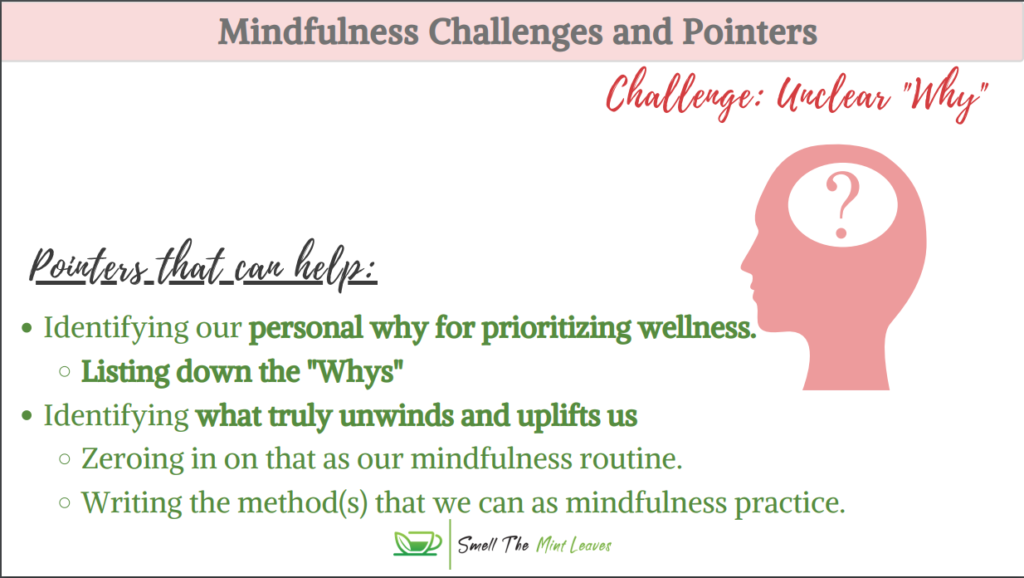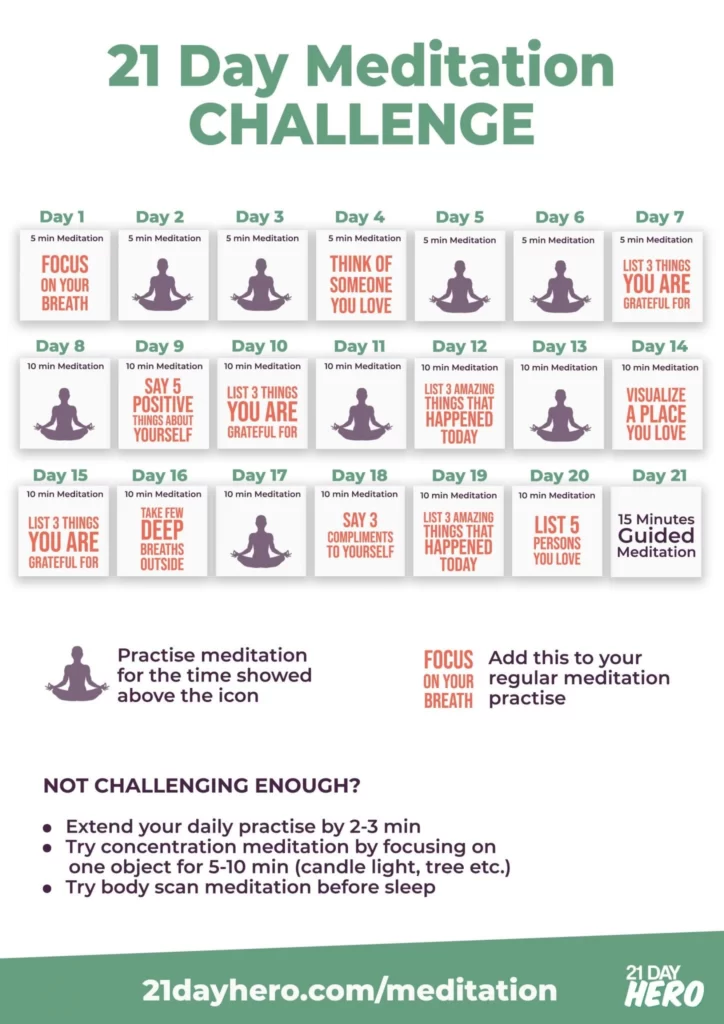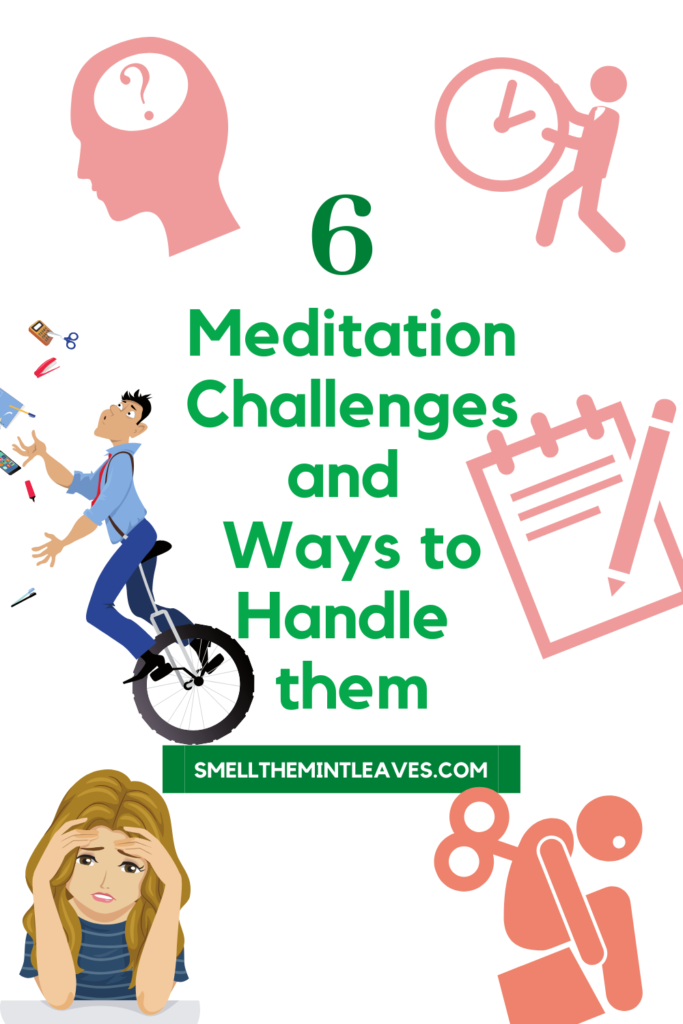
Challenges of maintaining a consistent meditation routine
Lack of time
One of the biggest obstacles in establishing a regular meditation practice is the perception of not having enough time. In our busy lives, it can be challenging to carve out dedicated time for meditation. However, it’s important to remember that even a few minutes of meditation can have significant benefits. Consider integrating meditation into your daily routine by finding pockets of time, such as during your lunch break or before bed, when you can dedicate a few moments to your practice.
Difficulty staying motivated
Another common challenge is maintaining motivation to meditate consistently. It’s natural to experience fluctuations in motivation, but there are strategies you can employ to overcome this hurdle. Setting specific goals for your meditation practice and tracking your progress can help keep you motivated. Additionally, finding a meditation buddy or joining a meditation group can provide accountability and support.
Distractions and interruptions
In our digitally connected world, distractions are abundant and can easily disrupt our meditation routine. To minimize interruptions, create a designated meditation space free from distractions, such as turning off your phone or finding a quiet corner in your home. Exploring different meditation techniques, such as mindfulness or mantra meditation, can also help in focusing your attention and reducing distractions.
Lack of commitment
Maintaining commitment to a consistent meditation routine can be challenging, especially when faced with competing priorities. Cultivating discipline and making meditation a non-negotiable part of your daily routine can help overcome this challenge. Use a visual reminder, like a sticky note or smartphone reminder, to prompt you to meditate daily. By treating meditation as a sacred commitment to yourself, you can reinforce its importance in your life.
Initial discomfort or difficulty
Sometimes, the initial stages of meditation can be uncomfortable or difficult. Restlessness, intrusive thoughts, or physical discomfort may arise. It’s essential to remember that meditation is a skill that takes time and practice to develop. Embrace these challenges as part of the learning process and be compassionate with yourself. Experiment with different meditation techniques, such as guided meditation or body scan, to find what works best for you.
Maintaining a consistent meditation routine can be challenging due to various factors such as lack of time, difficulty staying motivated, distractions and interruptions, lack of commitment, and initial discomfort or difficulty. However, by implementing strategies like finding pockets of time, setting goals, minimizing distractions, cultivating discipline, and being compassionate with yourself, you can overcome these challenges and establish a fulfilling meditation practice in your daily life.
Strategies to make meditation easier
Maintaining a consistent meditation routine can be challenging in our busy daily lives, but there are strategies that can make the process easier. One approach is visualization, where you imagine specific images or colors during meditation. For example, you could picture yourself in a serene natural setting or envision vibrant energy flowing through your body. This technique helps to engage your imagination and enhance focus.
Chanting is another effective strategy to deepen your meditation practice. By repeating a sacred mantra or simple phrase, you can redirect your thoughts and create vibrations throughout your body. This helps to center your mind and cultivate a sense of calm and clarity.
Counting breaths is a simple and structured method to improve concentration during meditation. As you breathe in and out, count each breath from 1 to 10. If your mind wanders, gently bring your focus back to the count. This practice helps to anchor your attention and bring you into the present moment.
Yoga nidra, a lying-down meditation technique, is an excellent approach for relaxation and rejuvenation. By following guided instructions, you can reach a state of deep relaxation while remaining conscious. This technique allows you to release tension and experience profound tranquility.
Focusing on sensations within your body is another valuable strategy. By directing your attention to the physical sensations you are experiencing, such as the feeling of your breath or the contact of your feet on the ground, you can ground yourself and connect with the present moment. This practice promotes mindfulness and helps to cultivate an awareness of your body and its sensations.
If sitting still proves challenging, moving with meditation can be a suitable alternative. Engage in mindful movements, such as walking or yoga, to combine physical activity with meditation. This active approach allows you to focus on the sensations in your body while promoting mindfulness.
Incorporate these strategies into your meditation routine and find what works best for you. Remember, there is no “right” way to meditate – the key is to be consistent and find practices that resonate with you.

This image is property of smellthemintleaves.com.
Visualization
Visualization is a powerful technique to enhance your meditation practice. By imagining specific images or colors during meditation, you can deepen your concentration and focus.
When visualizing, you can choose to imagine serene landscapes, like a peaceful beach or a lush forest. You can also envision vibrant colors, such as a calming blue or an energizing green. These visualizations create a mental space that is both serene and calming, allowing you to find tranquility amidst the chaos of daily life.
One strategy is to start by closing your eyes and taking a few deep breaths to relax. Then, visualize the image or color that resonates with you. Imagine yourself immersed in that image or surrounded by that color. As you continue to breathe deeply, let go of any distractions or thoughts that arise, and focus solely on the visualization.
Visualization can help create a peaceful and calming mental space, allowing you to enter a state of deep relaxation and inner peace. This technique is especially beneficial for those who struggle with racing thoughts or find it difficult to quiet their mind during meditation. Give it a try, and discover the transformative power of visualization in your meditation routine.

This image is property of 21dayhero.com.
Chanting
Chanting is a powerful meditation technique that can help you maintain a consistent meditation routine. It offers several benefits, including focusing the mind, creating vibrations throughout the body, and heightening spiritual connection.
Focusing the mind
Chanting is a way to redirect your thoughts and bring your attention to a single point. By repeating a specific mantra or phrase, you can quiet the mind and cultivate concentration. The rhythmic nature of chanting helps to anchor your awareness, making it easier to let go of distracting thoughts and find stillness within.
Creating vibrations throughout the body
Chanting involves using your voice, which creates vibrations that resonate throughout your entire body. These vibrations can be deeply soothing and comforting, helping to release tension and promote relaxation. As you chant, you may feel a sense of physical and energetic alignment, bringing a sense of harmony to your meditation practice.
Heightening spiritual connection
Chanting has been used for centuries as a spiritual practice in many traditions. The repetitive nature of chanting can invoke a sense of devotion and connection to something greater than yourself. It can deepen your spiritual experience, allowing you to connect with your inner self and the divine. Chanting can be a profound way to explore your spirituality and find peace within.
Incorporating chanting into your meditation routine can be a valuable tool for maintaining consistency and enhancing your practice. Experiment with different mantras, chants, or sacred sounds, and discover the transformative power of chanting in your meditation journey.

This image is property of smellthemintleaves.com.
Counting breaths
Providing structure and rhythm
One effective strategy to maintain a consistent meditation routine is by counting your breaths. This technique offers a sense of structure and rhythm to your practice, making it easier to stay focused and committed.
As you settle into a comfortable position, begin by taking a few deep breaths to center yourself. Then, gently start counting each inhalation and exhalation, from 1 to 10. The counting provides a simple anchor for your attention, preventing your mind from wandering off into distractions.
Enhancing mindfulness and awareness
Counting breaths can also enhance your mindfulness and awareness during meditation. By attentively observing each breath, you become more attuned to the physical sensations and subtle movements of your body. This heightened level of awareness can deepen your connection to the present moment and cultivate a sense of tranquility.
Improving focus and concentration
Furthermore, counting breaths improves focus and concentration. As you continuously count your breaths, you train your mind to remain attentive and undistracted. This practice strengthens your ability to direct your attention and resist the pull of wandering thoughts, allowing you to experience a greater sense of clarity and inner stillness.
Incorporating counting breaths into your meditation routine can provide the structure, mindfulness, and improved focus that you need to overcome challenges and maintain consistency. It is a versatile and accessible technique that can be practiced anywhere, making it a valuable tool in your meditation journey.
This image is property of i.insider.com.
Yoga nidra Lying down meditation technique
Yoga nidra is a powerful meditation practice that involves lying down while remaining awake and aware. This technique promotes deep relaxation and rejuvenation. By lying down and allowing your body to completely relax, you create a conducive environment for rest and restoration.
During yoga nidra, you are guided through a series of visualizations and body scans, helping you to cultivate awareness of your physical sensations and mental states. This technique allows you to observe and detach from your thoughts and emotions, leading to a state of calmness and tranquility.
Promoting deep relaxation and rejuvenation
Yoga nidra facilitates the release of tension from the body and mind, promoting deep relaxation. As you let go of stress and tension, your body enters a state of rejuvenation, allowing for physical and mental healing. This technique is especially beneficial for individuals experiencing high levels of stress, anxiety, or insomnia.
Reducing stress and anxiety
Through regular practice, yoga nidra can significantly reduce stress and anxiety. By consciously relaxing your body and mind, this practice activates the body’s natural relaxation response, reducing the production of stress hormones. This leads to an overall sense of calmness and well-being.
Incorporating yoga nidra into your meditation routine can be a wonderful way to enhance your overall meditation experience. By embracing the practice of lying down and guiding your mind towards a state of deep relaxation, you can tap into the transformative power of yoga nidra.
Focusing on sensations
Grounding and connecting to the present moment
Focusing on sensations in the body during meditation can be a powerful way to ground yourself and connect with the present moment. By redirecting your attention to the physical sensations you are experiencing, you can anchor yourself in the here and now.
As you sit in meditation, start by bringing your awareness to your breath. Notice the gentle rise and fall of your abdomen, the coolness of the air as you inhale, and the warmth as you exhale. Then, begin to scan your body from head to toe, observing any sensations that arise. It could be the feeling of the chair supporting your weight, the tingling in your fingers, or the pulsing of your heartbeat.
Enhancing body awareness and mindfulness
Focusing on sensations not only helps you stay present, but it also enhances body awareness and mindfulness. By honing in on the physical sensations in your body, you deepen your connection with yourself and cultivate a greater sense of self-awareness. This increased awareness can extend beyond meditation and into your daily life, allowing you to navigate your experiences with greater intention and clarity. As you become more attuned to your body’s signals, you can respond to its needs more effectively, whether it’s giving yourself a moment of rest when fatigued or nourishing your body with healthy foods when hungry.
Incorporating this strategy into your meditation routine can greatly support you in maintaining consistency. By grounding yourself in the present moment and enhancing body awareness, you can overcome challenges and experience the profound benefits of a regular meditation practice.
Moving with meditation
Alternative for those who struggle with sitting still
If you find it difficult to sit still for extended periods of time, don’t worry! There are alternative ways to practice meditation that involve movement. Moving meditations can be just as effective in cultivating mindfulness and peace of mind.
Benefits of walking meditation
Walking meditation is a popular form of moving meditation that involves bringing awareness to each step. As you walk, focus on the sensations of your feet touching the ground, the movement of your legs, and the rhythm of your breath. This practice allows you to stay present and anchored in the moment, while also experiencing the physical benefits of walking. Walking meditation can be done anywhere – in nature, on your daily commute, or even within the confines of your own home.
Benefits of yoga as a moving meditation
Yoga, with its combination of gentle movements and mindful breathing, is another excellent option for those seeking a moving meditation practice. The flowing sequences and asanas help to cultivate a deep mind-body connection, promoting relaxation, flexibility, and strength. By synchronizing movement and breath, yoga encourages a state of meditation in motion.
Experiment with different styles of yoga, such as Hatha or Vinyasa, and find the practice that resonates with you the most. Whether you prefer a dynamic flow or a slower-paced practice, yoga can offer a fulfilling moving meditation experience.
Remember, maintaining a consistent meditation routine doesn’t always require being stationary. Explore these alternative methods and find the one that suits your preferences and needs. Embrace the joy of moving meditation and discover a new way to connect with yourself and the present moment.

This image is property of i0.wp.com.
Conclusion
Maintaining a consistent meditation routine can be a daunting task in the busyness of daily life. However, by implementing various strategies and finding what works best for you, it is achievable. Remember, there is no “right” way to meditate. Whether you visualize specific images or colors, chant to focus your mind, count your breaths, practice yoga nidra while lying down, or simply focus on sensations in your body, each technique can help you stay grounded and connected to the present moment.
If sitting still is a struggle for you, consider moving with meditation through activities like walking or yoga. These alternatives can provide the same benefits as traditional sitting meditation. The key is to find what resonates with you and creates a consistent practice that aligns with your unique needs and preferences.
By persevering through the challenges and utilizing these strategies, you can overcome obstacles and cultivate a consistent meditation routine. With dedication and patience, you can experience the profound benefits that meditation brings to your overall well-being. So, commit to the practice, explore different techniques, and discover the transformation that awaits you on your meditation journey.